Hello, I’m Michael Zhang. As a traveler passionate about exploring world cultural heritage, I’ve visited churches in Italy, temples in India, and mosques in Iran. But the moment I stepped into Jokhang Temple in Lhasa, I felt a different kind of reverence—one that runs deep and ancient. This article takes you into the spiritual heart of Lhasa: Jokhang Temple. Based on my firsthand travel experience, I’ll guide you through its rich history, cultural significance, and practical travel tips. If you’re planning a trip to Lhasa or are curious about Tibetan Buddhism, this guide is a must-read.
Summary
Jokhang Temple Overview
Jokhang Temple, also known as “Zulakang” or “Jokhang” (meaning “House of the Jowo Shakyamuni” in Tibetan), is a sacred Tibetan Buddhist monastery originally built by King Songtsen Gampo. Lhasa owes its status as a “holy city” largely to the Buddha statue housed here. The temple was first called “Rasa,” a name that later evolved into “Lhasa” for the entire city. After its initial construction, the temple underwent multiple renovations and expansions during the Yuan, Ming, and Qing dynasties to become what it is today.
The architecture of Jokhang Temple blends Tibetan, Tang Dynasty Chinese, Nepalese, and Indian styles, making it a timeless model of Tibetan religious architecture. The air in front of the temple is thick with incense, and the worn stone slabs bear the imprint of countless full-body prostrations by devoted pilgrims. Thousands of butter lamps flicker inside, bearing witness to centuries of worship and pilgrimage.
- Address: No. 2, Bakuo West Street, Chengguan District, Lhasa (Apple Maps/Amap)
- Opening Hours:
- Winter: 9:00 AM – 6:00 PM
- Summer: 8:30 AM – 6:30 PM
- Recommended Visit Duration: 2 to 3 hours
- Best Time to Visit: All seasons
- Ticket Price: 85 CNY
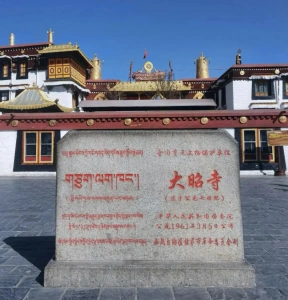
Why You Should Visit Jokhang Temple
Historical Background
Jokhang Temple was founded in the 7th century during the peak of the Tibetan Empire by King Songtsen Gampo. It was constructed to enshrine two life-sized Buddha statues: one of the 8-year-old Shakyamuni brought by Princess Bhrikuti of Nepal, and the other of the 12-year-old Shakyamuni brought by Princess Wencheng of the Tang Dynasty. The temple has witnessed centuries of Sino-Tibetan cultural exchange and has undergone major expansions during the Tang, Yuan, Ming, and Qing dynasties. Today, the temple complex covers 25,100 square meters and remains one of Tibet’s most impressive historical structures.
Religious Significance
Jokhang Temple holds immense religious importance. It is one of the three major monasteries of the Gelug school of Tibetan Buddhism. The central statue of the 12-year-old Shakyamuni is revered as “Jowo Rinpoche” and is considered one of the most sacred icons in all of Tibetan Buddhism. The temple’s pilgrimage paths and the faithful who prostrate along them offer a vivid glimpse into the profound spiritual life and traditions of the Tibetan people.
Cultural Value
In terms of cultural value, Jokhang Temple is a fusion of Tibetan, Han Chinese, and Nepalese architectural styles. The main hall stands four stories tall, faces south, and is crowned with a golden rooftop. Its murals and thangka paintings serve as invaluable resources for studying the art of the Tibetan Empire and Buddhist ritual practices. Moreover, Jokhang Temple is a key testament to Sino-Tibetan cultural exchange. In front of the temple stands the Tang-Tibet Alliance Tablet, inscribed in both Tibetan and Chinese, symbolizing the deep historical ties between the two peoples.
Architectural Features
The architectural style of Jokhang Temple is equally remarkable. Its main hall combines Han-style wooden beam structures with Tibetan fortress-style towers. The door frames, made of 7th-century sandalwood, still display original paintwork crafted by artisans from the Tibetan Empire. The temple’s artistic relics reflect the evolution of Tibetan art from the 7th to the 19th century, including murals, wood carvings, and thangkas—each one a gem of Tibetan cultural heritage.
Top Things to Do in Jokhang Temple
Main Highlights
Mandala
Known as “mandala” in Sanskrit, the Tibetan Buddhist Mandala symbolizes the structure of the universe and the perfection of wisdom. Inside Jokhang Temple, most mandalas are made of colored sand—vivid and intricate, crafted through precise rituals. Their creation is a sacred act of devotion and spiritual practice. Once completed, the sand mandalas are usually dismantled and poured into water, representing impermanence and emptiness. This ritual not only reflects core Buddhist teachings but also showcases the unique aesthetics of Tibetan religious art.
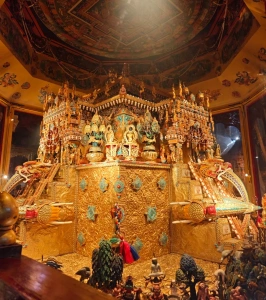
12-Year-Old Life-Sized Statue of Buddha (Main Deity of Jokhang Temple)
This statue is the most sacred and revered object in Jokhang Temple, widely considered the holiest artifact in all of Tibetan Buddhism. Legend has it that Princess Wencheng brought it from Chang’an during the Tang Dynasty. Cast in gold, it depicts the Buddha at age 12, with a serene and solemn expression. For over a thousand years, devotees have traveled vast distances to bow before this statue, offering prayers and devotion. For many Tibetan pilgrims, this is the ultimate destination of their spiritual journey.
.webp)
Ram God Jiemujie
Jiemujie is one of the temple’s protector deities, depicted as a ram and rooted in local folklore. According to legend, the construction of Jokhang Temple faced many challenges, until a ram helped carry soil to level the foundation. In gratitude, the ram was enshrined as the guardian of the temple. Today, visitors can still find the image of Jiemujie inside the temple, honoring its foundational role. The story reflects the Tibetan people’s spiritual bond with nature and lends a layer of mysticism to the temple’s origins.
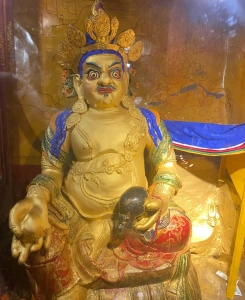
Wooden Guardian Beasts on the Second Floor
The wooden guardian beasts on the second-floor corridor of Jokhang Temple are fine examples of ancient Tibetan craftsmanship. These carvings feature animals such as elephants, lions, and dragons, each with unique poses and vivid detail. Beyond aesthetics, these beasts are believed to ward off evil spirits and serve as spiritual protectors. The carvings exemplify Tibetan religious artistry and also highlight the early artistic exchange between Tibetan and Central Chinese cultures.
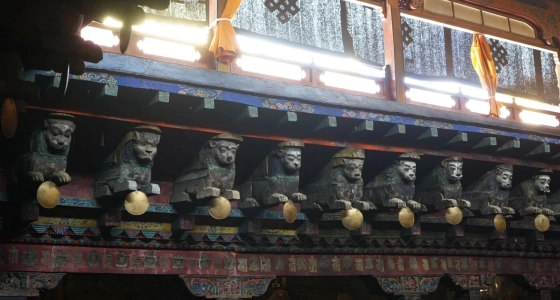
Golden Roof of Jokhang Temple
The golden roof stands as one of Jokhang Temple’s most iconic and visually stunning features. Located above the main hall, it is sheathed in gold and shines brightly above Lhasa’s old city. The golden rooftop not only symbolizes the temple’s elevated spiritual status but also represents a blend of Tibetan monastic and Chinese imperial architectural styles. From the second floor, visitors can admire the intricate structure of the roof and enjoy panoramic views of Barkhor Street and the surrounding old town—a favorite spot for photographers.
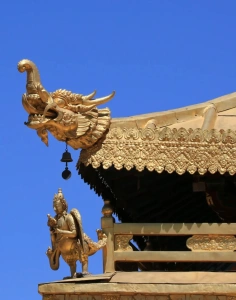
Jokhang Temple Ticket Guide
Online reservations are required in advance; tickets cannot be purchased directly online. After completing your online reservation, you must purchase the ticket on-site with a valid ID. Reservation timing matters:
- Morning visits are typically crowded. If your visit is for cultural interest rather than religious worship, the experience may feel rushed. The hall housing the 12-year-old Buddha statue is open in the morning. Worshippers should choose a morning slot to participate in the rituals.
- Afternoon visits are less crowded. However, entry into the statue hall is limited to those who donate gold leaf to the statue. Around 5 PM, you may witness monks engaging in debates and chanting. If visiting around 6 PM, be aware that the second floor may be closed.
Jokhang Temple Ticket Prices
- Adult/Child/Senior: 85 CNY
- Free Admission: Children under 10 years old
How to Reserve Tickets
- Online: Use the official WeChat Mini Program by copying (#小程序://大昭寺/6Kjd2yZyHHScGYF) into a WeChat chat window and clicking it. You can only reserve one day in advance. Note that this is a reservation, not a purchase—you must still buy your ticket at the temple with your ID.
- Seniors aged 60+ do not need a reservation; they can purchase tickets on-site with ID.
- Before 13:30, entry must match your reservation time exactly. On Sundays, the entry time is more flexible.
- Important: On-site reservations are not possible. If you miss your reservation, your only chance is to politely ask a staff member for leniency—there’s no guarantee. Be sure to book in advance!
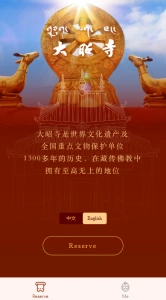
Suggested Visiting Route for Jokhang Temple
The route through Jokhang Temple is linear. Recommended route:
- Start at the courtyard and proceed clockwise. Visit the main hall first to admire the intricate statues and murals.
- Then head to the Jokhang Hall, which houses the 12-year-old statue of Shakyamuni Buddha. This is the spiritual core of the temple—pay your respects sincerely.
- Continue to the second floor for a view overlooking Barkhor Street. The scenery here is spectacular.
- Finish at the golden rooftop. Under the sunlight, you can truly feel the architectural brilliance of Tibetan design.
- Notes:
- Make sure to reserve in advance
- Do not wear short skirts, sandals, shorts, or ripped jeans
- Photography inside the main hall is strictly forbidden
- No loud talking is allowed
- Hiring a guide is recommended; without one, your visit might be over in less than 30 minutes
- You can request a monk to bless a personal item (offering a donation is customary)
- If you’re here for worship, prepare small change to leave in front of the statue as an offering
- There are two levels open to visitors; if you arrive too late, the second floor may be closed
Recommended Local Restaurants Near Jokhang Temple
Snowland Restaurant (Danjielin Road)
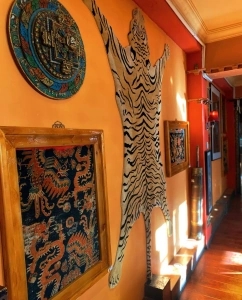
- Why Visit: A classic Tibetan-style restaurant that’s also a popular photo spot—especially at night. The service is warm, and the menu features a broad selection: Nepalese, Indian, Turkish, and Western dishes.
- Address: 1st Floor, No. 8 Zangyiyuan Road, Chengguan District, Lhasa (near Jokhang Temple) (Apple Maps/Amap)
- Opening Hours: Monday–Sunday, 08:00–22:00
- Average Price: 57 CNY per person
Amdo Norzen Tibetan Restaurant (Main Branch)
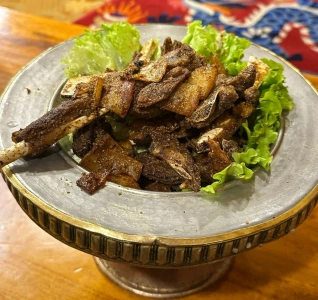
- Why Visit: A true collision of Tibetan ambiance and culinary experience. With carved wooden façades, thick wood tables, butter lamps, and staff in traditional dress, the setting is atmospheric. Highly recommended dishes include Amdo yak beef pancakes and deep-fried butter lamb chops.
- Address: No. 27, Jiri 4th Alley, Chengguan District, Lhasa (Apple Maps/Amap)
- Opening Hours: Monday–Sunday, 10:30–23:00
- Average Price: 64 CNY per person
Recommended Hotels Near Jokhang Temple
Zhaxi Quta Style Hotel
.webp)
- Location: 6-minute walk from Jokhang Temple
- Price per night: from 388 CNY
- Check Rates: Trip.com Specials
- Rating: 9.6 on Trip
- Special Amenities: Laundry room, triple rooms available
The hotel enjoys an excellent location near both Potala Palace and Jokhang Temple, making it ideal for sightseeing. From the moment you enter the lobby, you’re immersed in rich Tibetan décor—exquisite thangka paintings, traditional curtains, and intricately carved wooden furniture together create an atmosphere that feels like a corridor through mystical Himalayan culture.
Known for its stylish design and luxurious amenities, the rooms are spacious and comfortable, and the breakfast buffet is diverse and plentiful. The hotel also offers oxygen supply systems and a medical room—perfect for guests concerned about altitude sickness.
Thangka Hotel
.webp)
- Location: 4-minute walk from Jokhang Temple
- Price per night: from 450 CNY
- Check Rates: Trip.com Specials
- Rating: 9.4 on Trip
- Special Amenities: Laundry room, triple rooms available
The location is unbeatable—right next to Jokhang Temple and just a 10-minute walk to Potala Palace. Plenty of dining options are nearby, and the hallways are beautifully decorated with colorful thangka paintings.
While the decor feels a bit dated, the hotel is clean and well-maintained. It features both diffuse and nasal oxygen supply systems available 24/7, which is very helpful for guests adjusting to the altitude.
The St. Regis Lhasa Resort
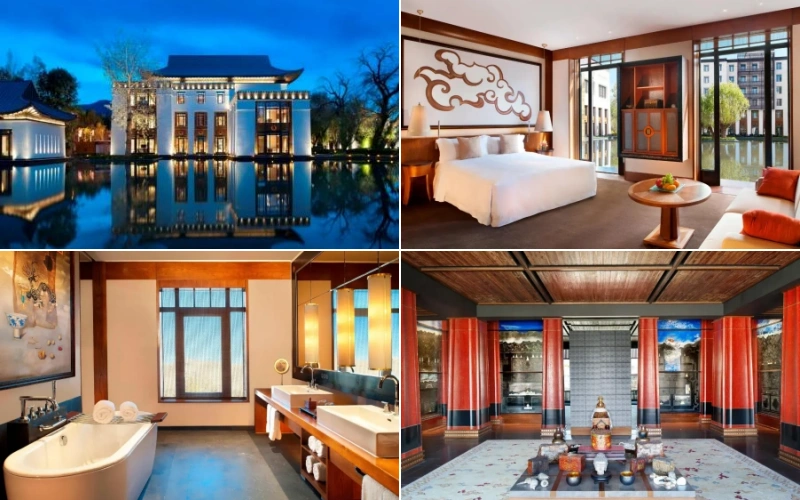
- Location: 7-minute walk from the Great Mosque of Lhasa
- Price per night: from 1,349 CNY
- Check Rates: Trip.com Specials
- Rating: 9.5 on Trip
- Special Amenities: Laundry room
Arguably the finest hotel in Lhasa, it’s located conveniently close to Barkhor Street, and you can see the Potala Palace right from the room.
True to the understated luxury of the St. Regis brand, the hotel is elegant without being showy. Facilities are top-notch, with stylish interiors, ultra-comfortable bedding, and in-room humidifiers.
How to Get to Jokhang Temple from Downtown Lhasa
If budget is not a major concern, taking a taxi is the most convenient way. If you’re staying near the Potala Palace, you can simply walk—it’s about a 25-minute walk.
Public Bus
Public buses in Lhasa are very affordable—just 1 CNY. Many lines stop near Jokhang Temple, including routes 14, 15, 20, 25, and 28.
Ride-hailing Services
Jokhang Temple is located right in the city center, so ride-hailing is both quick and cheap. Most rides will take under 20 minutes and cost around 15 CNY.
FAQ
Unfortunately, it is not. Visitors must climb stairs and walk throughout the temple complex.
There is no luggage storage service at Jokhang Temple. It’s recommended to leave your belongings at your hotel.

 English (US)
English (US)  English (Hong Kong)
English (Hong Kong)  English (Malaysia)
English (Malaysia)  English (Singapore)
English (Singapore)  繁體中文
繁體中文 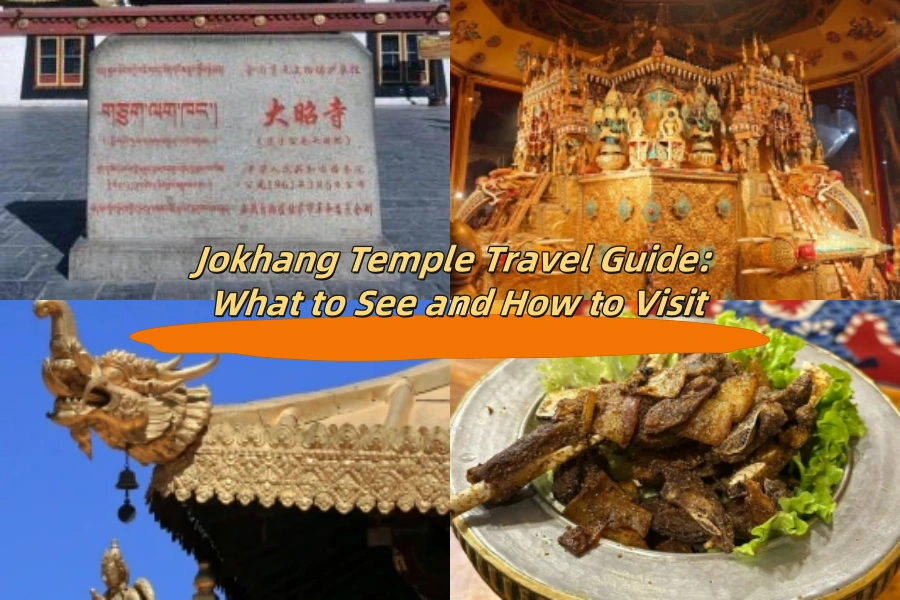
Comment (0)